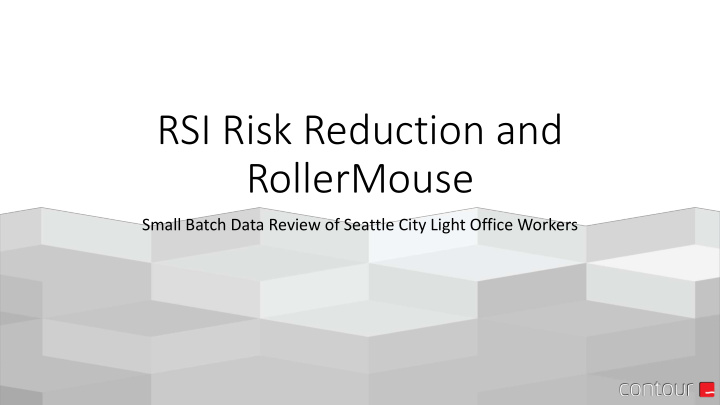



RSI Risk Reduction and RollerMouse Small Batch Data Review of Seattle City Light Office Workers
Takeaways • Short term results of risk and pain reduction using RollerMouse. • Potential long term effects of continual use of RollerMouse. • Productivity changes with measured employees. • Company savings.
Initial evaluation • A standard ergonomic assessment was conducted for each individual. • The ergonomic assessment for all office workers is now an annual requirement for all City Light employees who spend at least 40% of their week at a workstation. • Determinations for changes to the workstation are based on an ergonomic review and the employees inputs to the online risk assessment tool.
Employees in the Review • There were 14 employees that were in this review: • Their initial risk levels were: • 8 High Risk (750 or higher) • 5 Medium Risk (300-749) • 1 Low Risk (0-299) • They initially had the following types of input devices (mouse): • 6 had a different type of rollermouse • 2 were using “ergonomic” style devices with roughly 45 degrees of slant • 6 had the standard mouse issued with desktop PC setups
Employees in the Review • No employees were using an ergonomic keyboard such as the Sculpt, Logitech Wave, or other contoured type keyboard. • All employees were initially using standard keyboards. • 8 employees were later transitioned to a keyboard without a 10-key attached due to minimal 10-key usage. • 6 Kinesis Freestyle 2 keyboards • 2 Evoluent keyboards
Data Review • Primary data was taken solely from our online risk management tool. • Baselines were each employees initial assessment and evaluation. • Additional information was pulled using interviews with both users and supervisors: • Quality of work • Efficiency changes • Perceived comfort levels (verified with the risk tool) • Employees were from a variety of job descriptions within City Light: • 60% were from Customer Service jobs • 30% were DAs or Department Administration • 10% were from Engineering
WMSD Complaints • All 14 employees had discomfort with their shoulders, neck, elbows, and hands to varying degrees. • Discomfort levels are measured by the tool as: • None • Occasional • Frequent • Constant • A review of the data showed: • All users had elevated levels of discomfort. • Level was measured as either frequent or constant. • The lone low risk employee was beginning to develop issues.
Changes to the Workstations • Employees were given the Contour RollerMouse Red because: • Elevated shoulder discomfort from reaching for their standard mouse. • Prolonged computer work due to the nature of their job tasks. • Trial usage of other ergonomic devices did not show any improvement in the affected areas. • Follow-ups for the employees were done based on Risk levels: • High risk were followed up at 30 days. • Medium risk were followed up at 60 days. • Low risk were followed up at 90 days.
Initial Follow-up Data • Excellent results using the RollerMouse Red. • Follow-up assessments from the users showed: • 42% decrease in risk scores for High Risk employees. • 37% decrease in risk scores for Medium Risk employees. • 15% decrease in risk score for the Low Risk employee. • This number speaks directly to the overall score for the employee. • This change can also be impacted by other changes that were made to each employees workstation, however those changes were minimal in scope.
6 Month Check-up • After 6 months there was an additional 20-33% decrease in discomfort. • This decrease was directly related to the affected areas: • Shoulders 33% • Neck 25% • Elbows 27% • Hands 20% • The requirement for annual assessments has shown (only 8 of this 14 have completed to date): • A further 15% decrease in discomfort for High Risk users (5). • A further 11% decrease in discomfort for Medium Risk (3).
Productivity Changes • Although difficult to directly measure, our online risk tool does calculate for changes in lost productivity. • The average loss time for the users of RollerMouse Red prior to issuance was 38 minutes daily. • After 6 months of usage this number has decreased to 30 minutes. • This translates to an efficiency increase by this group alone of 347.6 recouped productive minutes. • That is roughly $287K in recouped productivity (based on avg. salary).
Conclusions • Short term pain mitigation was evident when the RollerMouse Red was issued and the employees were coached on how to effectively use it. • Data shows that mid and long term use has continued to show further decreases in both targeted discomfort levels and overall employee risk. • There were measured productivity increases and decreases in lost or unproductive time for each employee. • Supervisors and employees were happy with the results from using the RollerMouse Red and the fact that there is a solid ergonomic process to use now.
Questions?
Thank you Keith Osborne Ergonomist Seattle City Light
Recommend
More recommend